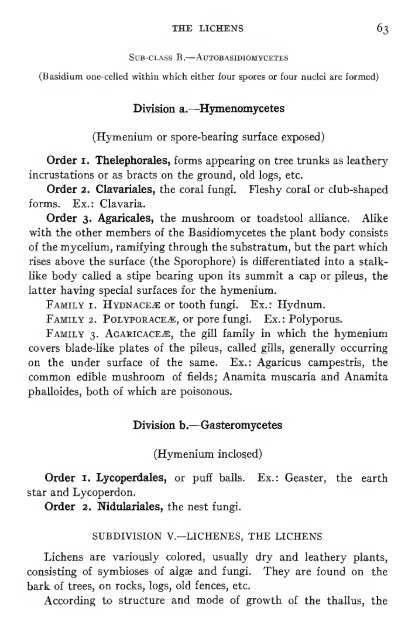Pharmaceutical botany - Lighthouse Survival Blog
Pharmaceutical botany - Lighthouse Survival Blog
Pharmaceutical botany - Lighthouse Survival Blog
Create successful ePaper yourself
Turn your PDF publications into a flip-book with our unique Google optimized e-Paper software.
THE LICHENS 63<br />
Sub-class B.— Autobasidiomycetes<br />
(Basidium one-celled within which either four spores or four nuclei are formed)<br />
Division a.—^Hymenomycetes<br />
(Hymenium or spore-bearing surface exposed)<br />
Order i. Thelephorales, forms appearing on tree trunks as leathery<br />
incrustations or as bracts on the ground, old logs, etc.<br />
Order 2. Clavariales, the coral fungi. Fleshy coral or club-shaped<br />
forms. Ex.: Clavaria.<br />
Order 3. Agaricales, the mushroom or toadstool alliance. Alike<br />
with the other members of the Basidiomycetes the plant body consists<br />
of the mycelium, ramifying through the substratum, but the part which<br />
rises above the surface (the Sporophore) is differentiated into a stalk-<br />
like body called a stipe bearing upon its summit a cap or pileus, the<br />
latter having special surfaces for the hymenium.<br />
Family I. Hydnace^ or tooth fungi. Ex.: Hydnum.<br />
Family 2. Polyporace^, or pore fungi. Ex. : Polyporus.<br />
Family 3. Agaricace^, the gill family in which the hymenium<br />
covers blade-like plates of the pileus, called gills, generally occurring<br />
on the under surface of the same. Ex.: Agaricus campestris, the<br />
common edible mushroom of fields; Anamita muscaria and Anamita<br />
phalloides, both of which are poisonous.<br />
Division b.—Gasteromycetes<br />
(Hymenium inclosed)<br />
Order i. Lycoperdales, or puff balls. Ex.: Geaster, the earth<br />
star and Lycoperdon.<br />
Order 2. Nidulariales, the nest fungi.<br />
SUBDIVISION v.—LICHENES, THE LICHENS<br />
Lichens are variously colored, usually dry and leathery plants,<br />
consisting of symbioses of algae and fungi. They are found on the<br />
bark of trees, on rocks, logs, old fences, etc.<br />
According to structure and mode of growth of the thallus, the
















